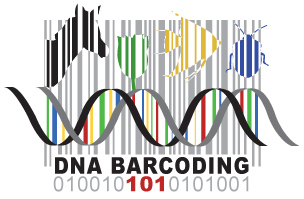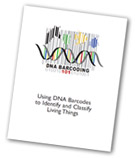
Reagents
For each group (for amplifying 2 samples)
- For Ready-To-Go PCR Bead Amplification:
- 2 Ready-To-Go PCR Beads in 0.2- or 0.5-mL PCR tubes
- Appropriate primer/loading dye mix (50 µL; 23 µL per reaction)*
- For NEB Taq 2X Master Mix Amplification:
- Master Mix (30 µL; 12.5 µL per reaction)*
- Appropriate primer/loading dye mix (25 µL; 10.5 µL per reaction)*
- DNA from specimen(s) (from Part II)*
*Store on ice
Shared Supplies and Equipment
- Container with cracked or crushed ice
- Micropipettes and tips (2–100 µL)
- Microcentrifuge tube rack
- PCR tube rack
- Permanent marker
- Thermal cycler
To amplify a DNA barcode region, choose the most appropriate set of primers for each sample. The table below lists available primer sets, the type of organism they target, and the PCR protocol for each set. For detailed information on the primer sets, go to Barcode Primer Sequences. Instructions for Ready-to-Go PCR Bead amplification included here; for NEB Taq 2X Master Mix Amplification follow directions in Planning and Prep.
- Obtain PCR tube containing Ready-To-Go PCR Bead containing dehydrated Taq polymerase, nucleotides, and buffer. Label the tube with your identification number.
- Use a micropipette with a fresh tip to add 23 µL of the appropriate primer/loading dye mix to each tube (refer to primer table below). Allow the beads to dissolve for 1 minute at ambient temperature.
- Place the PCR tubes on ice to prevent premature replication of unwanted primer dimers.
- Use a micropipette with fresh tip to add 2 µL of your DNA (from Part II) directly into PCR tube with primer and polymerase mixture. Ensure that no DNA remains in the tip after pipetting.
- Store your sample on ice until your class is ready to begin thermal cycling.
- Place your PCR tube, along with those of the other students, in a thermal cycler that has been programmed with the appropriate PCR protocol.
Amplification from some templates, such as the COI barcode region, may be improved by transferring PCR tubes directly from ice into a hot thermal cycler that has been temporarily paused at the beginning of the first 95°C denaturation step. This limits the formation of undesirable primer dimers. Resume the program when all of the PCR tubes are in the thermal cycler.
- Initial step: 94°C 1 minute
- 35 cycles of the following profile:
- Denaturing step: 94° C 15 seconds
- Annealing step: 54° C 15 seconds
- Extending step: 72° C 30 seconds
- One final step to preserve the sample: 4° C ad infinitum
- Initial step: 94°C 3 minutes
- 41 cycles of the following profile:
- Denaturing step: 94° C 30 seconds
- Annealing step: 48° C 40 seconds
- Extending step: 72° C 1 minute
- Additional extending step: 72° C 10 minutes
- One final step to preserve the sample: 10° C ad infinitum
- Initial step: 95°C 2 minutes and 30 seconds
- 35 cycles of the following profile:
- Denaturing step: 95° C 30 seconds
- Annealing step: 56° C 30 seconds
- Extending step: 72° C 30 seconds
- Additional extending step: 72° C 10 minutes
- One final step to preserve the sample: 10° C ad infinitum
- Initial step: 94°C 4 minutes
- 35 cycles of the following profile:
- Denaturing step: 94° C 1 minute
- Annealing step: 54° C 30 seconds
- Extending step: 72° C 1 minute
- One final step to preserve the sample: 10° C ad infinitum
- Initial step: 94°C 1 minute
- 35 cycles of the following profile:
- Denaturing step: 94° C 15 seconds
- Annealing step: 54° C 15 seconds
- Extending step: 72° C 30 seconds
- One final step to preserve the sample: 4° C ad infinitum
- Initial step: 94°C 1 minute
- 35 cycles of the following profile:
- Denaturing step: 94° C 15 seconds
- Annealing step: 54° C 15 seconds
- Extending step: 72° C 30 seconds
- One final step to preserve the sample: 4° C ad infinitum
- Initial step: 94°C 1 minute
- 35 cycles of the following profile:
- Denaturing step: 95° C 30 seconds
- Annealing step: 50° C 30 seconds
- Extending step: 72° C 45 seconds
- One final step to preserve the sample: 4° C ad infinitum
- Initial step: 95°C 3 minutes
- 10 cycles of the following profile:
- Denaturing step: 95° C 10 seconds
- Annealing step: 45° C 30 seconds
- Extending step: 72° C 45 seconds
- 30 cycles of the following profile:
- Denaturing step: 95° C 10 seconds
- Annealing step: 50° C 30 seconds
- Extending step: 72° C 45 seconds
- Additional extending step: 72° C 1 minute
- One final step to preserve the sample: 4° C ad infinitum
- Initial step: 94° C 1 minute
- 35 cycles of the following profile:
- Denaturing step: 94° C 1 minute
- Annealing step: 55° C 1 minute
- Extending step: 72° C 2 minutes
- One final step to preserve the sample: 4° C ad infinitum
- Initial step: 94° C 1 minute
- 35 cycles of the following profile:
- Denaturing step: 94° C 30 seconds
- Annealing step: 54° C 30 seconds
- Extending step: 72° C 45 seconds
- One final step to preserve the sample: 4° C ad infinitum
- After thermal cycling, store the amplified DNA on ice or at -20° C until you are ready to continue with Part IV.
If the reagents become splattered on the wall of the tube, pool them by briefly spinning the sample in a microcentrifuge (with tube adapters) or by sharply tapping the tube bottom on the lab bench.
If your DNA was extracted using Chelex, allow the tubes containing DNA to sit upright for 10 minutes (or centrifuge for 30 seconds) to ensure that any residual Chelex settles on the bottom of the tubes. When removing DNA for PCR, be careful to only pipet from the very top of the liquid to avoid transferring Chelex into the PCR tube as Chelex inhibits PCR.
To use adapters, “nest” the sample tube within sequentially larger tubes: 0.2 mL within 0.5 mL within 1.5 mL. Remove caps from tubes used as adapters.
Primers |
Profile |
Plant |
|
Plant |
|
Plant |
|
Plant (algae-specific) |
|
Vertebrate (non-fish) |
|
Vertebrate (fish) |
|
Invertebrate |
|
Invertebrate (ant) |
|
Fungi |
|
Fungi (lichen specific) |
|

 Download Protocol PDF
Download Protocol PDF